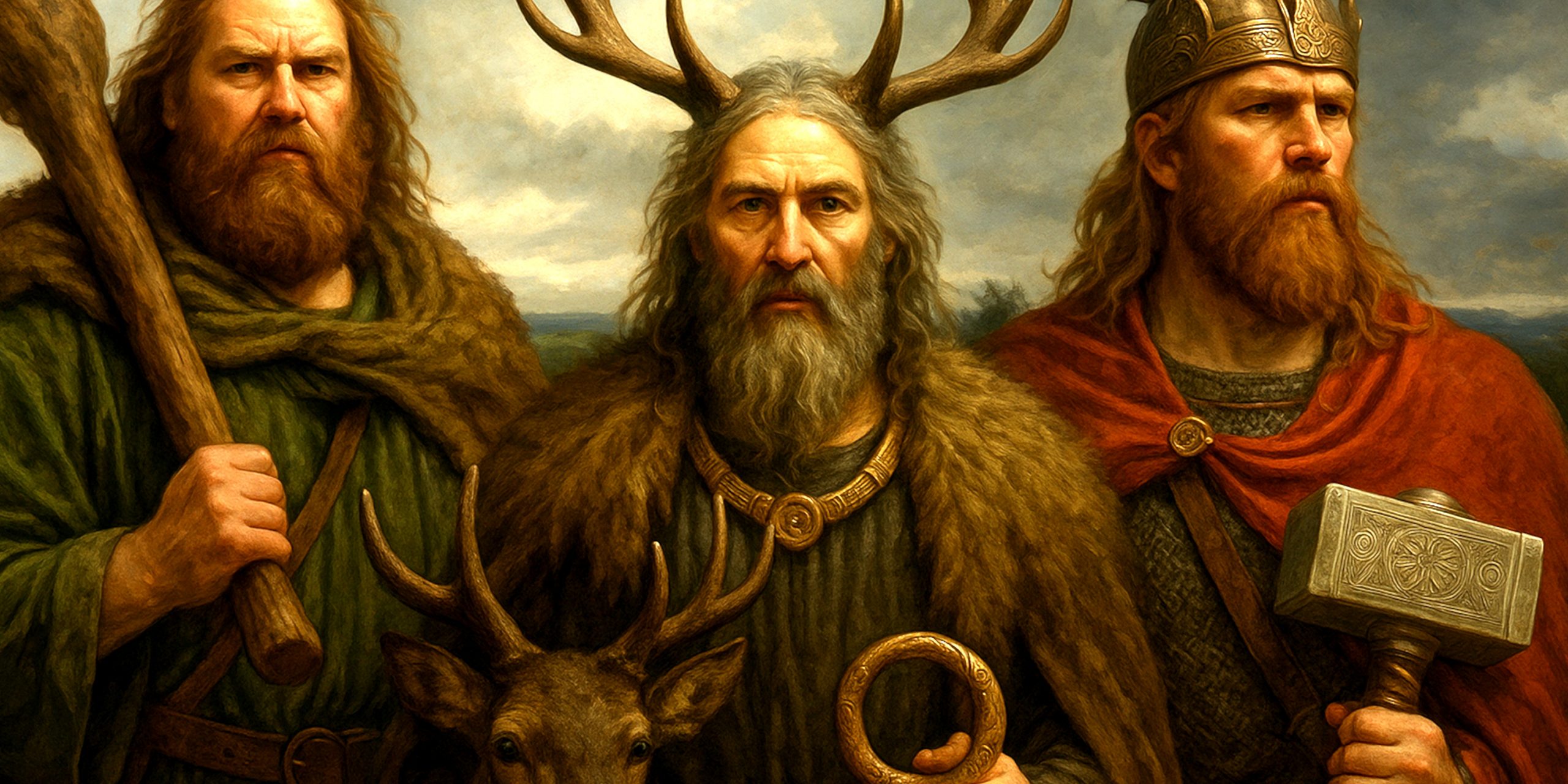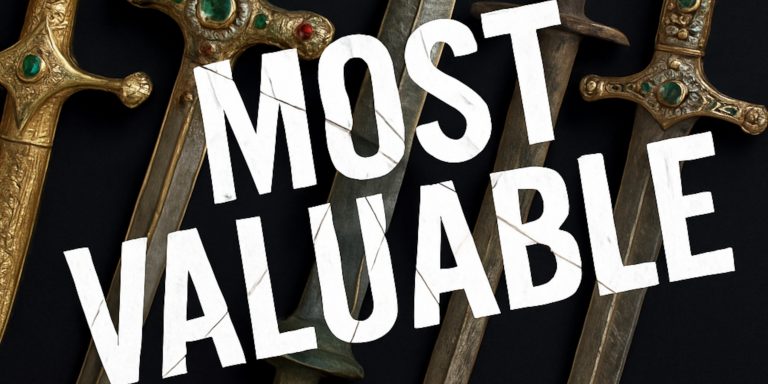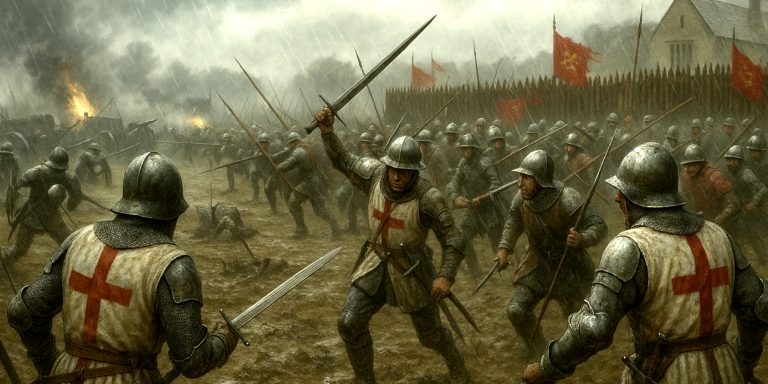
A Historian’s Guide To A Pantheon That Refuses To Sit Still
Celtic religion does not hand you a nice neat family tree. It gives you fragments, place names, inscriptions, echoes in myth, and the occasional Roman writer who seemed more interested in showing off his Latin than understanding what the locals believed. So when we try to sketch the Celtic gods, we are not dealing with a tidy Olympus. We are dealing with a shifting landscape of local cults, shared ideas, and regional personalities that somehow feel vivid even through the fog.
Below is a look at the major deities known across Britain, Ireland and Gaul.
The Big Figures Of The Celtic Pantheon
The Dagda
The Dagda looms large in Irish tradition. He is portrayed as a kingly figure with a colossal appetite, yet also a master of magic, wisdom and fertility. His great club can both kill and revive, which sounds like the sort of tool you should keep well out of reach of visiting dignitaries. He presides over life, land and prosperity.
There is an earthy practicality to him that makes him one of the most human of the divine figures. He is powerful, generous, often slightly chaotic, and seems deeply comfortable with all of it.
Lugh
Lugh is the skilled god, the many gifted one who can outfight, outthink or outperform anyone he encounters. Irish tradition makes a point of emphasising his talents in almost every craft, which is either a cultural celebration of versatility or a very long way of saying that Lugh did not enjoy being told he could not join in.
He stands for kingship, battle prowess, art and intellectual achievement. He is also associated with the festival of Lughnasadh, a seasonal marker of harvest and community.
Brigid
Brigid is a complex figure. She appears as a goddess of healing, poetry and smithcraft. Later Christian tradition reshaped her into St Brigid, which only adds to the confusion when you attempt to map her origins.
Her presence in Irish sources hints at a deeply rooted cult of renewal, craft and inspiration. She represents the spark in the hearth, the poem in the mind, and the blade fresh from the forge. One cannot help but admire her range.
The Morrigan
The Morrigan is fierce, enigmatic and remarkably difficult to pin down. She is linked to battle, fate and sovereignty, and often appears as a crow observing fields of conflict.
Her role is not simply to revel in war but to shape its outcome, to declare victory or ruin with unsettling clarity. She is part protector, part omen, part judge, and part uncomfortable reminder that the Celts had no interest in sanitising their myths.
The Gods Of Gaul And Britain
Cernunnos
Cernunnos is the antlered god often shown seated cross legged, holding a torc and sometimes accompanied by animals. He seems to embody wild nature, abundance and the liminal space between the civilised and the untamed.
He never speaks in the surviving sources, yet his image is so striking that many assume he must have been central to Gaulish spirituality. He feels like the deity who would be perfectly polite but absolutely refuse to come indoors.
Epona
Epona is the great horse goddess of the continental Celts and widely revered among cavalry units in the Roman army. She protects travellers, fertility and the bond between horse and rider.
She carries a distinctive prestige. Any culture that reveres horses tends to revere her, and she appears calm, assured and watchful in almost all depictions.
Taranis
Taranis is associated with thunder and the sky. His name survives in Continental inscriptions, and Roman commentators linked him loosely with Jupiter. He is shown with a wheel, a symbol that might represent the turning of the heavens or the unstoppable force of storms.
He has the assured presence of a god you would rather not call upon unless you truly needed to. Sky deities rarely do subtle.
Maponos
Maponos appears as a youthful god associated with music, healing and poetic inspiration. His cult reached across Britain and Gaul, suggesting a figure of shared cultural significance.
There is a gentler touch to him, a reminder that Celtic spirituality valued not only warriors and kings but also artistry and renewal.
Nodens
In Britain, Nodens emerges as a healing and sea associated god, confirmed by the impressive temple complex at Lydney Park. He blends attributes of the hunt, protection and restoration.
He feels like one of the more grounded deities, with a practical focus on recovery and safe passage.
Goddesses Of Sovereignty And Landscape
Celtic religion has a deep fascination with the land itself. Many goddesses embody rivers, regions or kingdoms, reinforcing the bond between community and landscape.
Danu
Danu stands at the roots of the Irish pantheon. She is linked to ancestry and the divine family known as the Tuatha De Danann. Her presence is more foundational than narrative. She is the ground beneath their stories.
Macha
Macha carries ties to territory, kingship and battle. Several different Machas appear in the sources. Scholars still debate whether they are separate figures or regional aspects of one goddess. The Celts, for their part, do not seem to have worried about this in the slightest.
Boann
Boann is the divine personification of the River Boyne, one of the great sacred waterways of Ireland. She represents creativity, knowledge and the power of flowing water. Her myth about approaching a forbidden well shows the familiar Celtic blend of curiosity, consequences and transformation.
How Celtic Religion Actually Worked
Celtic worship was intensely local. Every region had its own sacred pools, groves, hills and springs. Deities often had overlapping roles and names, shaped by language and geography. Roman rule added another layer, since Roman writers frequently equated Celtic gods with their own, sometimes helpfully and sometimes with all the precision of someone translating after only two weeks of Latin lessons.
This means that while we recognise broad themes like sovereignty, the natural world, war or craftsmanship, each area had its own expressions. A god revered at one river might be unknown at the next, even if the two were twenty miles apart. It creates a patchwork pantheon that is challenging to reconstruct yet deeply rewarding to explore.
Legacy In Later Tradition
The gods survived through folklore, place names and medieval literature. Christian scribes preserved many myths, often unintentionally, turning them into heroic cycles or allegories. Deities such as Brigid and possibly even the Morrigan passed into legend with new guises.
Modern interest has revived study of these figures, although one must tread carefully. Many popular claims drift happily away from the evidence. Still, the ancient material holds enough richness to keep historians, archaeologists and linguists busy for a lifetime.
The Seven Swords Takeaway
The Celtic gods form a pantheon that moves like a landscape in mist. Shapes appear, details sharpen, then recede again. Yet across Ireland, Britain and Gaul we find shared patterns that hint at how Celtic communities understood their world.
They imagined gods who governed craft, war, poetry, rivers, horses and kingship. They found power in the land itself. They created deities as bold and contradictory as human experience.
If anything, the lack of tidy structure makes the pantheon more compelling. The Celts did not write a manual. They left reflections, symbols and stories, inviting us to piece things together and argue about it for centuries, which is exactly what historians tend to do anyway.



